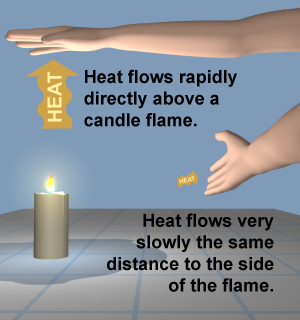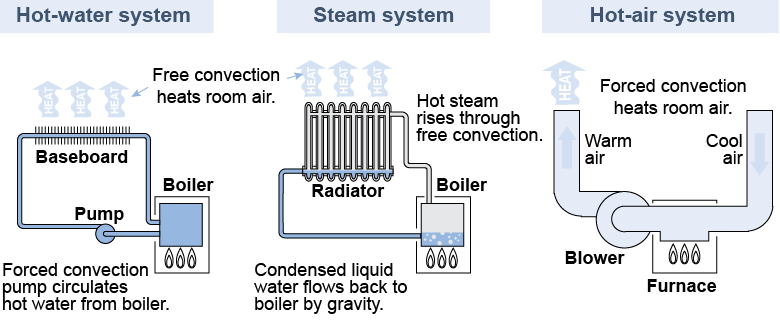|
 A hair dryer heats a surface by blowing hot air. This is an example of convection. Convection is the transfer of heat by the motion of liquids and gases. You can experience convection yourself with a candle flame. Your hand gets hot even a half meter above the flame while at the same distance to the side of the flame produces little sensation of heat at all. You feel heat directly above the flame because the hot air rises and carries the heat with it, an example of convection. To the side, there is some heat transfer through conduction and radiation, but air is an insulator so the amount of heat is barely detectable.
A hair dryer heats a surface by blowing hot air. This is an example of convection. Convection is the transfer of heat by the motion of liquids and gases. You can experience convection yourself with a candle flame. Your hand gets hot even a half meter above the flame while at the same distance to the side of the flame produces little sensation of heat at all. You feel heat directly above the flame because the hot air rises and carries the heat with it, an example of convection. To the side, there is some heat transfer through conduction and radiation, but air is an insulator so the amount of heat is barely detectable. 
|
Free convection occurs when the fluid moves on its own because of differences in density caused by differences in temperature. The convection above the candle flame is an example of free convection. Forced convection occurs when fluid flow is driven by wind, pumps, fans, or other means. The blower in a hair dryer is an example of forced convection. Convection is the dominant means of large-scale heat transfer within Earth’s atmosphere and its oceans. Vast wind patterns move heat through the atmosphere. Enormous currents circulate warm ocean water from equatorial areas to higher latitudes and cold water from the poles to warmer latitudes. 
|

|
In many situations convection transfers heat between a surface and water or air. For example, many homes are heated by steam or hot water in baseboards or radiators. Free convection heats the air, which flows around the room. In a hot-water system, finned-tube baseboards are heated by forced convection from a pump that circulates hot water from the boiler throughout the house. In a steam system, hot steam rises through natural convection through radiators, carrying heat to each room. In a forced-air system the furnace heats air that is circulated by a blower to each room in the house. The air blower creates forced convection—moving heat by moving hot air. 
|
|
|
| |
|

